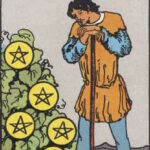The Hanged Man is one of the more intriguing cards in the Tarot deck, often eliciting a plethora of interpretations across various perspectives. When viewed through the lens of Christian theology, this card presents a rich tapestry of meaning that merits exploration. As we delve into its symbolism and implications, we shall uncover how this enigmatic card mirrors profound spiritual truths and invites contemplation about faith, sacrifice, and redemption.
At first glance, the Hanged Man appears to be a figure caught in suspension, hanging upside down by one ankle from a sturdy tree branch. This image can evoke discomfort or confusion; however, it is essential to recognize that this position is not one of torment but rather of deliberate choice. In Christian thought, this suspension can be seen as a poignant metaphor for the state of surrender, which is central to the faith. Just as Christ submitted to His crucifixion, embracing pain for the greater good, the Hanged Man symbolizes the strength found in vulnerability and the transformative power of sacrifice.
The number twelve in the Hanged Man card often connects with the story of the twelve apostles, who each faced their own trials and tribulations in following Christ. It signifies a period of waiting and reflection—a crucial aspect of the Christian journey where believers are called to trust in God’s timing. The act of willingly relinquishing control reflects the biblical principle found in Proverbs 3:5-6, which emphasizes the importance of leaning not on one’s own understanding but rather trusting in God. The Hanged Man, thus, becomes a representation of those who seek to align their will with divine purpose, often at the expense of worldly desires.
Moreover, the symbolism of the tree in the Hanged Man card can evoke the Tree of Life, both in its biblical context and broader metaphysical interpretations. In Christian theology, the Tree of Life is often associated with the resurrection and eternal life, signifying that through sacrifice comes hope. The Hanged Man’s pause in life can be likened to a gestation period—a moment of preparation for one’s spiritual rebirth. This has striking parallels with the Christian concept of dying to oneself, mirroring the metamorphosis that occurs through faith.
Within the state of suspension, one may find enlightenment. The Hanged Man possesses a unique perspective, seeing the world upside down. This perspective shift may represent the kingdom of God, which often defies societal norms and expectations. The biblical notion that “the last will be first, and the first will be last” (Matthew 20:16) resonates deeply with the connotations of the Hanged Man. Through the embodiment of humility, one learns that elevation often arises from a place of surrender.
In terms of emotional and spiritual growth, the Hanged Man invites Christians to embrace patience and contemplation. In our fast-paced world, where immediate gratification is the norm, this card serves as a gentle reminder that true understanding often requires time. It ignites a call to stillness, urging believers to pause and reflect on their spiritual journey. In moments of quietude, one cultivates the capacity to discern the divine, leading to a more profound connection with God.
The stark contrast between the Hanged Man’s passive stance and the active pursuit of faith also presents an intriguing dialogue about the complexities of Christian life. While faith demands action, it also necessitates moments of stillness. In this way, the Hanged Man embodies the dual nature of the Christian journey—one that both requires movement in grace and an embrace of waiting. Such dynamics reflect the inherent tension between faith and fear, light and darkness, as believers navigate their spiritual path.
Notably, the Hanged Man also embodies the theme of sacrifice leading to enlightenment. In Christianity, sacrifice is the cornerstone of Christ’s message. The crucifixion is not merely seen as an end but as a new beginning—evoking the promise of resurrection and renewal. The Hanged Man, suspended in his state, showcases how the willingness to let go can birth transformative experiences. It calls into question what personal sacrifices one might need to make for spiritual elevation and a deeper communion with God.
Furthermore, this card invites contemplation on the nature of surrender itself. In a Christian context, surrender is often misconstrued as a sign of weakness; however, the narrative of the Hanged Man elucidates that surrender can be a form of strength. It beckons individuals to explore their relationship with control, prompting an introspection on the things that truly matter. In letting go of ego, pride, and superficial desires, believers can more fully embrace what God has in store for them.
Ultimately, the Hanged Man reveals the profundity of faith in action—or perhaps, inaction. It invites individuals to lean into the mystery of existence, embracing the paradoxes that inform the Christian faith. Through sacrifice, surrender, and stillness, one may find the key to unlocking deeper truths. The Hanged Man is a powerful reminder that in the moments where we feel most lost or suspended in uncertainty, it is often the divine at work, fostering growth from within.
In conclusion, the Hanged Man in the realm of Tarot offers a compelling exploration of Christian themes. Its imagery serves as an invitation—not to fear being in limbo but to find meaning in the ebb and flow of spiritual life. As one contemplates the Hanged Man, they are reminded that it is often in the depths of suspension that the most profound revelations await.








Leave a Comment